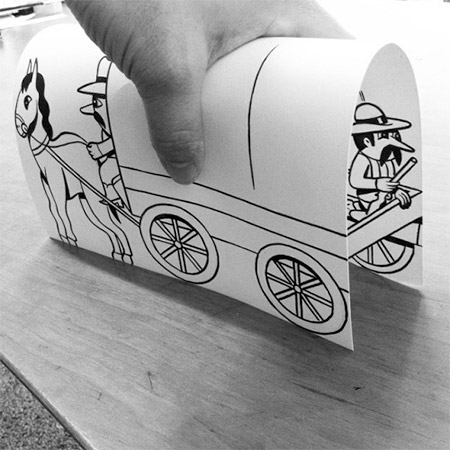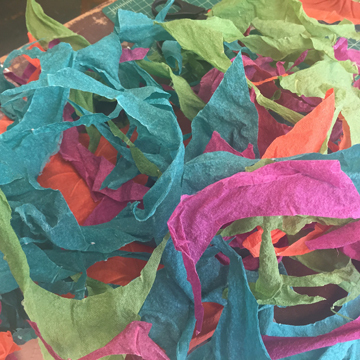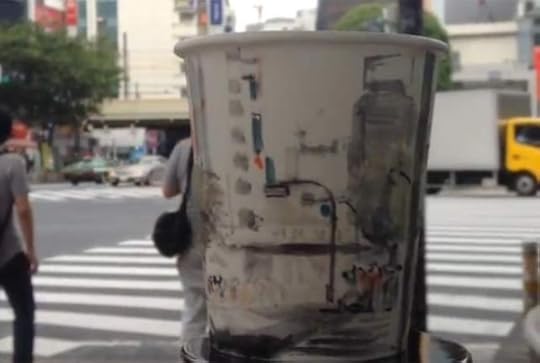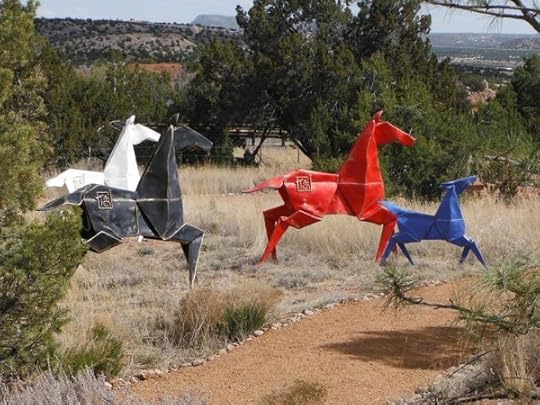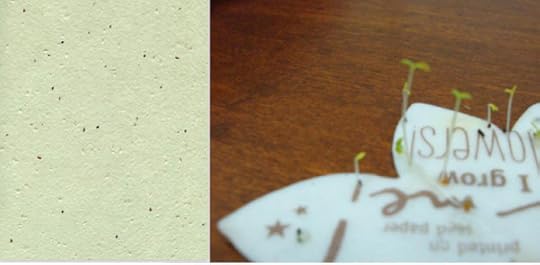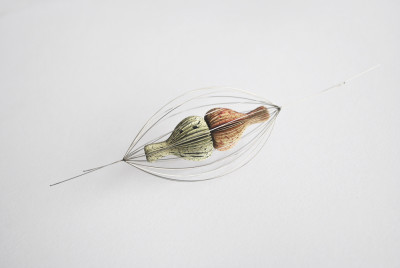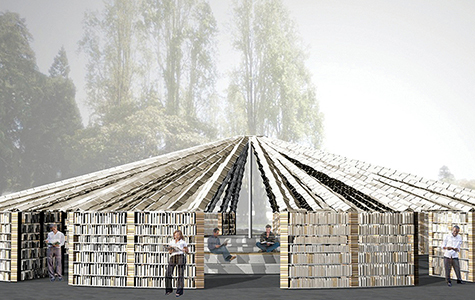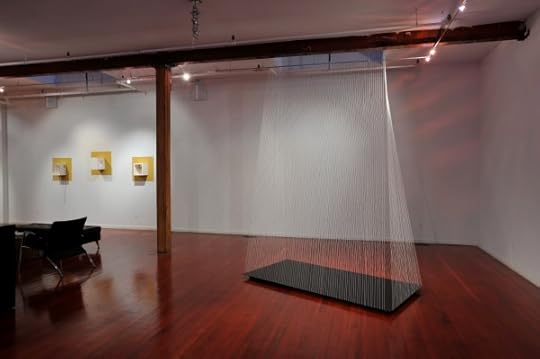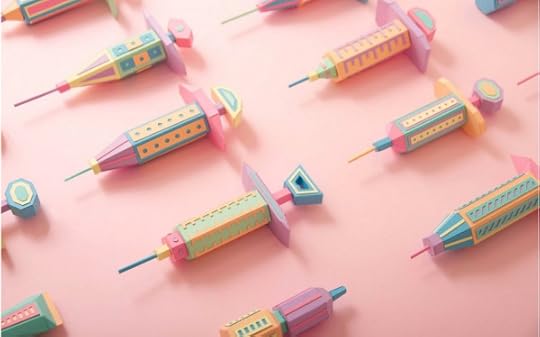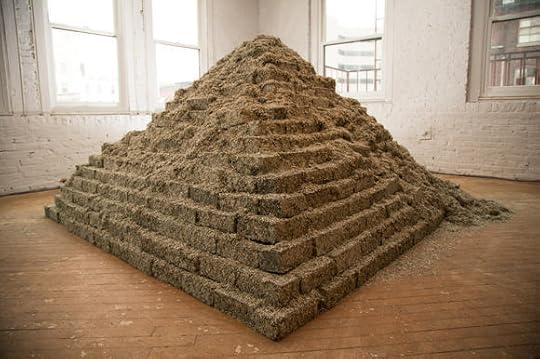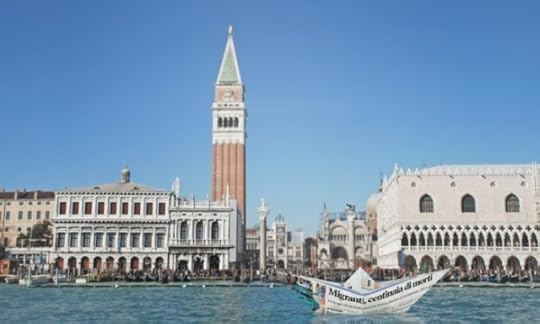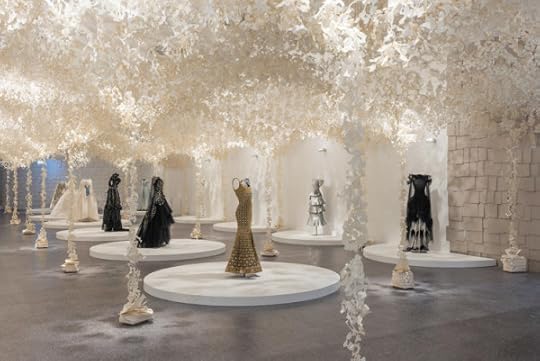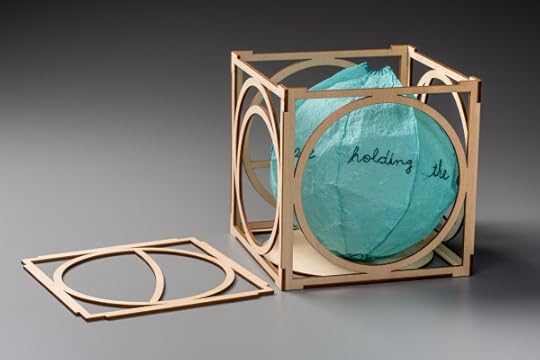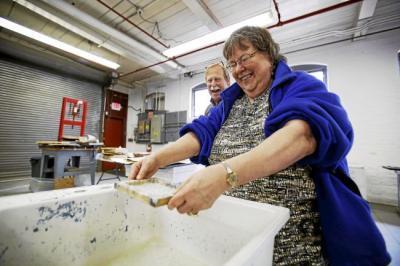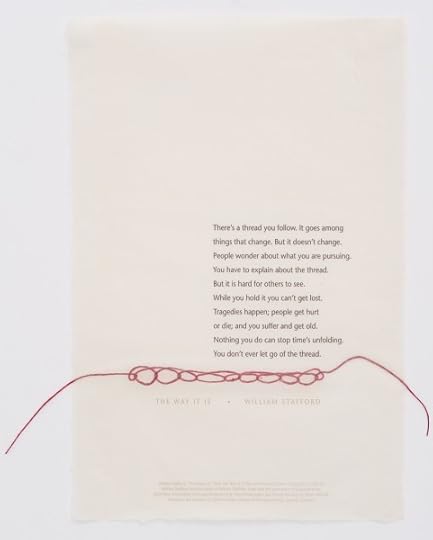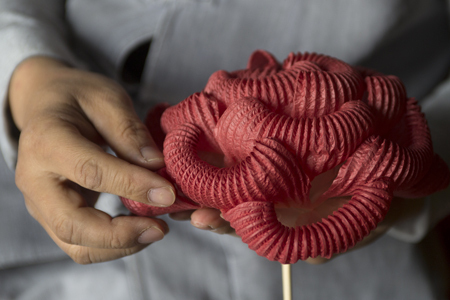Helen Hiebert's Blog, page 62
June 13, 2015
The Secret Life of Paper
The Sunday Paper #59
Paper of the Week: Stained Tyvek
An accordion night light project, which can be found on page 76 of my book Playing With Paper.
I learned about Tyvek® in a workshop (perhaps with Hedi Kyle) and then picked it up again a couple of years ago when I was designing projects for my book Playing With Paper. It folds really well, is super strong and water resistant. You know, its that stuff they use in construction, protective apparel and packaging (no wonder I like it – it has qualities of paper and cloth). It comes in white (and black) and I use watered-down acrylic paints to pigment my sheets, brushing the paint on with a foam sponge and wiping off the excess. The staining picks up the texture in the Tyvek®, which creates a lovely pattern. By the way, Tyvek® is not paper, but the way it cames about sounds really similar to the story told about T’sai Lun (credited with making the first paper). I love the story of inventions. T’sai Lun is said to have noticed the fibers from laundry collecting on rocks in the river and matting together. The discovery of Tyvek® was made by a DuPont researcher, Jim White, who in 1955 noticed white polyethylene fluff coming out of a pipe in a DuPont experimental lab. A program to develop the new material was set up, and a year later DuPont submitted a patent proposal for this strong yarn linear polyethylene.
——————————————————————————————————————————————
In the Studio: Anjani Millet recently published this poetic review of my film Water Paper Time. I hope you will take the time to read it and watch the trailer.
Here’s an excerpt:
“Helen opens Water Paper Time with a story of children who have never seen, touched, or written on paper. What? Really? I had never thought of that either. All my life, I’ve had the privilege of having paper in my life. I’ve printed my photographs on paper, and my writing on paper; I’ve drawn on it, painted it, inked, glued, crumpled, torn, kept, discarded it, folded it up around gifts, and made my own. I’ve cried over pieces of paper and laughed over others. But I had no idea paper could be alive, could do what Helen so lovingly coaxes it to do. Now I know. This film introduced me to the secret life of paper.”
If you like what you read and see, you can download and own Water Paper Time for $4.99.
——————————————————————————————————————————————
Speaking of Hedi Kyle, have you checked out the exhibition at 23 Sandy Gallery? HELLO HEDI is a juried exhibition of book art celebrating this influential book artist. The exhibition features 56 books by 53 artists, all of which emulate or adapt the book structures Hedi invented. I have taken a few classes with Hedi over the years, and so respect her inventive and innovative mind, and in this exhibition we get to see many of those she has inspired.
Vellicate by Karen Hardy, featured in the current exhibition HELLO HEDI at 23 Sandy Gallery
I don’t have a problem finding an open meeting room in my office, since I’m the only one who works here. But this device filled the need of some creative minds over at Viget. Illumigami is a light they can hang outside of meeting rooms to let people know whether a room was in use. It was thought of as something similar to an “On Air” light. Red means the room is in use, green means it’s available. Now that’s just clever.
Check out these clever illustrations on folded white paper by talented Danish artist HuskMitNavn. Drawings on both sides of the paper sheet encourage interaction and make the art look three-dimensional.
Jocelyn Chateauvert is one of my all time favorite artists. Why? Because she works sculpturally with abaca in incredible ways. And she has a new website!! Be careful not to drool on your computer as you peruse her work.
Grasses, by Jocelyn Chateauvert
I will never cease to be amazed by what can be done with a single sheet of paper. Watch this video of the creation of a spiraling paper tower by origami expert Chris Palmer. Nothing turns into something, and a flower transforms into a tower.
——————————————————————————————————————————————
 Would you consider making a donation to support the research, writing, design and delivery of The Sunday Paper? Click on that cute paper button (I made that paper) to see how you can provide support. And if you run a paper-related business, you might be interested in promoting your business in The Sunday Paper.
Would you consider making a donation to support the research, writing, design and delivery of The Sunday Paper? Click on that cute paper button (I made that paper) to see how you can provide support. And if you run a paper-related business, you might be interested in promoting your business in The Sunday Paper.
Thank you to those who have pledged your support, and enjoy your Sunday!
June 6, 2015
Catching the Light
The Sunday Paper #58
Paper of the Week: Kite Paper
I discovered kite paper when my daughter went to a Waldorf preschool and they made these gorgeous folded and layered paper light catchers. It is just like wax paper, and it comes in a dozen brilliant colors. You can purchase it in large sheets or in packs of assorted colors that are cut to 6-1/4″ square. The first project in my book Playing With Paper features a how-to project for making the window star pictured above. I also sell a Window Star Kit that includes 10 sheets of kite paper and instructions. I think you can imagine that the variations on this project are infinite, and I love the way that light filtering through the layers adds dimension to these stars. They are also fun and simple to make!——————————————————————————————————————————————
In the Studio: Speaking of brilliant colors, I have this pile colorful abaca leather remnants taking up space in my studio. Click here to enter the Rafflecopter giveaway: two lucky winners (US entries only please) will win a box stuffed full of these remnants!
——————————————————————————————————————————————
I am always intrigued with the fact that a single sheet of paper can be transformed into something completely different through cutting, folding, crumpling and other forms of manipulation. Paper cutting is one way of altering a sheet, and Suzy Taylor’s Folk Art Papercuts are a lovely example of this.
My friend Mindy Dubansky is a librarian who collects Blooks! Check out this video to find out more, and if you’re interested you can also support her fundraising efforts for an exhibition of her amazing collection that will take place at the Grolier Club in NYC next January.
Here’s an intriguing rotating paper canvas. Be sure to click through to the instagram feed of Adrian Hogan‘s work and watch some of the videos to see how these paper cups interact with street scenes in situ.
Kevin Box makes monumental origami-inspired sculptures fabricated in metal. If you are in or around Santa Fe (or in Florida in the coming months), you have an opportunity to tour Origami in the Garden.
Remember the red PaperBridge by Steve Messam that I wrote about a couple of months ago? Here’s a video showing the finished bridge as well as the power of the arch form. Do you think the camera was operated by a drone?
——————————————————————————————————————————————
 Would you consider making a donation to support the research, writing, design and delivery of The Sunday Paper every week? Click on that cute paper button (I made that paper) to see how you can provide support. And if you run a paper-related business, you might be interested in promoting your business in The Sunday Paper.
Would you consider making a donation to support the research, writing, design and delivery of The Sunday Paper every week? Click on that cute paper button (I made that paper) to see how you can provide support. And if you run a paper-related business, you might be interested in promoting your business in The Sunday Paper.
Thank you to those who have pledged yours support, and enjoy your Sunday!
May 30, 2015
It’s resilient, it’s resourceful, it’s portable, it’s foldable…
The Sunday Paper #67
Featured Paper of the Week: Grow A Note® Green by Green Field Paper Company
I’ve always loved the concept of planting paper and watching it grow. Paper has always been a carrier for information, and this image makes it look like a clever binder for seed starts! I was pleasantly surprised when I recently discovered Green Field Paper Company, and a bit surprised that it took this long. They started out making paper by hand the same year I did (1992).
Grow A Note® papers are handmade from 100% post-consumer pulp in San Diego, California. The paper hues (in a range of 40 colors) come from earth pigments, and they are embedded with wildflower seeds. They also make a selection of papers with herbs or vegetables. The sheets are 13×19 inches with a natural deckle edge on all four sides, and natural white (no color) is easiest to print. Greenfield Paper offers offset printing services, and while they can print full color, they recommend two or three color for cost and because of the nuances of printing on handmade paper. Grow A Note® papers can be used for greeting cards, invitations, promotional pieces (mailings and handouts) and packaging.
Green Field Paper Company is offering a 15% discount through June 30, 2015. Just enter promo code HH15 at check-out.
——————————————————————————————————————————————
Thank you to those of you who have sent support for The Sunday Paper (you can skip this section)!
 I have a little favor for the rest of you … would you consider making a donation to support the research, writing, design and delivery of The Sunday Paper every week? Click on that cute paper button (I made that paper) to see how you can provide support. And if you run a paper-related business, you might be interested in promoting your business in The Sunday Paper.
I have a little favor for the rest of you … would you consider making a donation to support the research, writing, design and delivery of The Sunday Paper every week? Click on that cute paper button (I made that paper) to see how you can provide support. And if you run a paper-related business, you might be interested in promoting your business in The Sunday Paper.
Thank you, and enjoy your Sunday!
——————————————————————————————————————————————-
In the Studio:
Since I launched The Wish Project which resulted in a permanent installation in Denver, my wish has been to return the individual wishes that I collected out into the world. I’m working on a series of small sculptures that represent these wishes that were integrated into a sound component of the installation in Denver. These will be available to ship worldwide later this summer.
In the meantime, I’m going to be raffling off two large piles of the colorful handmade abaca paper off-cuts you see pictured below right. More details in the next Sunday Paper!

——————————————————————————————————————————————-
I recently discovered this beautiful laser cut paper jewelry by Jocelyn He on the Daily Art Muse.
If you know me, you know that I’m a huge fan of paper and light. This is an interesting story about the plight of the traditional Japanese lanterns of Gifu which show off Japanese Washi in a lovely way. It sounds to me like a retake on the mayor of Gifu in the 1950’s, who asked the Japanese-American artist Isamu Noguchi to revitalize the economy by designing contemporary light objects based on the traditional Gifu lanterns. Noguchi’s lanterns have surpassed the test of time and are still available today. We’ll have to wait and see how the town’s designs are faring in another 50 years. I do wish them success!
A group of volunteers is planning to build a library out of books for the inaugural Bay Area Book Festival this June. They hope that visitors will get lost in a book, literally!
Check out this high-tech View-Master (remember that toy?). Google introduced its virtual reality viewer — a cardboard box, with some lenses and a magnet, that looks a lot like a plastic View-Master toy — as a gift at last year’s I/O conference and they recently announced several programs that aim to put its rendition, called Cardboard, at the center of a growing online world in which people can use their smartphone and YouTube to watch videos rendered in 3-D.
Did you catch the NPR series about paper this week? Here’s a radio excerpt (and it’s also where I found my headline thanks to Nicholas Basbanes, the author of On Paper: The Everything of Its Two-Thousand-Year History).
About Our Paper of the Week Sponsor
Founded in 1992 and located in San Diego, CA, Green Field Paper Company has always crafted eco-friendly papers. Their signature papers include Grow A Note® handmade paper embedded with seeds, Paperevolution® handmade paper infused with recycled material such as junk mail, garlic skins and clothing scraps and Hemp Heritage® machine made paper using 25% North American grown hemp fiber and 25% post-consumer pulp. Green Field Paper Company has done projects for Whole Foods, Delta Airlines, GM, MLB, NFL, Campbell Soup, Sea World and many others.
Special thanks to Green Field Paper Company for sponsoring this post and for their contribution to the world of handmade paper!
May 23, 2015
Mixing Business & Philanthropy in Exotic Places
The Sunday Paper #66
Dear Readers,
 I have a little favor … would you consider making a donation to support the research, writing, design and delivery of The Sunday Paper every week? Click on that cute paper button (I made that paper) to see how you can provide support. And if you run a paper-related business, you might be interested in promoting your business in The Sunday Paper.
I have a little favor … would you consider making a donation to support the research, writing, design and delivery of The Sunday Paper every week? Click on that cute paper button (I made that paper) to see how you can provide support. And if you run a paper-related business, you might be interested in promoting your business in The Sunday Paper.
Thank you, and enjoy your Sunday!
——————————————————————————————————————–
In the Studio: In 2009, I created my only installation (to date) that had absolutely nothing to do with paper. My installations are usually site specific, and I had the opportunity to exhibit at the now defunct Ogle Gallery in Portland. I was drawn to the large skylights in the space and decided to draw with string, connecting that skylight to the same shape on the floor. It was interesting to walk around the piece and view the piece and the space from different vantage points. The shadows changed throughout the day too. I like to think that I made something out of nothing, because the space without this piece was just air. The piece was called Holding Space.
Holding Space, © 2009 Helen Hiebert, wood, eyelets, thread, installation at Ogle Gallery, Portland, OR, 12′ x 8′ x 4′
Paper of the Week: Abaca Leather with Embedded String

This is a handmade abaca paper; those of you who follow my work know that I’m obsessed with abaca, a fiber from the leaf stalk of a non-fruit bearing banana plant. I’ve developed this paper over the years. It is made from premium abaca fiber that I beat in my Reina beater for about 3 hours. Next, I double-couch two sheets of paper, sandwiching a thin linen thread in between. The sheet was air dried, misted and then dried under restraint. The papers featured in the Support The Sunday Paper button above are pigmented abaca leather (one layer, no string). I’m making this particular paper for my next artists’ book, 50 Revolutions, and you’ll be able to purchase the extra sheets during my on-line paper sale later this summer.
Now for that headline. It came from this article about Everest Art Paper in the aftermath of the Nepal earthquakes. I can’t find much information about the company, but it sounds like over the years the business leapt beyond just the making of paper and applied its resources to organic farming, tourism, vocational training, educational and cultural programs and micro-community development. If you live in the Boulder, CO area, you can take part in the Two Hands Paperie-Etsy Craft Party Fundraiser for Nepal on June 5th. (Please note that as far as I know, these two things are not directly related – just helping out the same country).
Jennie Frederick was the first person to acquire an MFA in papermaking… that shows you how young this field is! Here’s a nice article about her work in the Kansas City Star, and just look at that lovely (and clean) studio.
East London designer Kyla McCallum makes some amazing lighting pieces that are now available in the US. One thing I love about lamps is that they look so different when they are on and off. Illuminating in more ways than one!
Have you seen my pop-up alphabet? If you don’t already subscribe to this blog, click here, sign up and you’ll receive a template for creating this fun three-dimensional font!
Speaking of templates, here’s one for creating your very own Orion Crew Vehicle out of paper. My husband used to tell my son that he’d be the first person on Mars. I’m doubtful, but I am happy to know much more than I ever would about space because I married him. And of course he’s the one who found this template!
May 16, 2015
Cardborigami, Paper Vaccines & Wet-Folding
In the Studio:
This week’s work brings you The Paper of the Week, a new column in The Sunday Paper.
Stay tuned… in the coming weeks, I’m going to be inviting you to:
support my blog by making a donation if you’re a reader
sponsor The Paper of the Week by promoting your products if you’re a supplier
And as always, a big thank you for following my adventures in paper!

P.S. I’ve created a pinterest board that features all of the previous issues of The Sunday Paper. Check it out!
Paper of the Week: Vegetable Papyrus
Vegetable Papyrus: left to right: green pepper, daikon radish, red pepper, zucchini
When steamed, pressed and dried, slices of vegetables fuse together to make this unusual paper, and the intricate patterns of the seeds and veins in the veggies become visible. Real papyrus, used in ancient Egypt, Greece, and Rome, is made by overlapping pieces of the stalk of the papyrus plant, then pounding or pressing the pieces together. This technique can also be used with slices of common household vegetables (but don’t expect your veggie papyrus to be as durable or long lasting as traditional papyrus). Find detailed instructions for making this paper in my book Papermaking with Garden Plants & Common Weeds.
Have you made vegetable papyrus? I’d love to hear what vegetables or fruits were successful.
The Sunday Paper #55
Cardborigami, have you heard of it? Wow! Watch this video about Tina Hovsepian, the 2015 Toyota Mother of Invention winner, a remarkable woman honored for contributing to her community and the world through innovation, entrepreneurship, and invention. Check out her cardboard origami homeless shelters that are helping people all over the world.
Now I know that vaccinations are a touchy subject, but the French duo Zim & Zou has created a vibrant series of vaccination tools (pretty enough to charm even a worried kid) as part of the Art of Saving a Life, a cross-disciplinary campaign to help bring life-saving vaccines to children everywhere.
As far as I know, wet folded origami is only done by a few, and it takes finesse: too little water and the paper dries before the folding is done; too much water, and the paper will rip. Check out Vietnamese artist Hoàng Tiến Quyết’s incredible animals, as featured on Bored Panda.
Have you heard of lunchbag art? These parents make art on their kids paper lunch bags and napkins. Imagine the delight when they take out their lunch at school. Some parents feel challenged or even threatened (those competitive souls) – and I get that – but come on, we all need more art in our lives (and what a creative way to bring art back into schools)!
Nina Levy’s luxuriously decorated paper napkin for her son Ansel
A 2009 PBS story about Jim and Melody Croft has been recirculating around the internet this week. This is a lovely profile of the couple, who intentionally live much different lives than most of us.
May 9, 2015
On Paper Wings
Work of the Week: Over 400 people (including some of you) have contributed roots to the Mother Tree Project since I launched it in Portland in 2009. Six years later, I’m still dwelling on this theme that was sparked when I overheard a father telling his children that me nursing my baby was one of the most beautiful things in the world. My work centers around similarities and connections. After pondering that comment (for years) I decided to focus on mother’s milk as a thread that connects women of all time.
Mother Tree at UIS Springfield, 2011. Women’s Center members crocheted roots and then walked the labyrinth.
I was born on Mother’s Day in 1965 and have often tried to conjure the feelings my own mother must have had on that day, because her first child (the one before me) was stillborn. Unimaginable. In 2010, a group of women in Australia got together on Mother’s Day and crocheted roots for my sculpture. I am humbled by the many others who have contributed their stories and roots to this project. It is my hope that one day Mother Tree will be a permanent installation somewhere, perhaps in a place of healing.

I am not one for big celebrations, but I do enjoy honoring traditions, including making paper and handwriting. My grandmother had a tablecloth that she put out for family reunions. We all wrote our names on it, spiraling out from the center. Between reunions she would embroider the names, and the tablecloth is now a family heirloom that contains the hands of many. I’ve just completed embroidering 50 people’s handwritten words about mother/motherhood on this skirt.
The Sunday Paper #54
A colleague posted recently about this Radiolab show featuring the Japanese balloon bombs of WWII. Did you know that 9,000 giant paper balloons were launched carrying bombs across the jet stream towards the US? It is refreshing to listen to a story on the radio (please take 30 minutes – you will enjoy it). The story briefly mentions the film On Paper Wings by Ilana Sol, a documentary of four Japanese women who worked on balloon bombs, the families of those killed in the U.S., and the man whose actions brought them all together forty years after WWII, and the balloon bomb project. I met Ilana when I lived in Portland, and my hands made a cameo in her film, making paper of course!
Balloon in hangar: A caption reads: “Overall photograph of Japanese balloon inflated with apparatus properly suspended.” (Photo Credit: National Archives and Records Administration)
Oh my gosh this is so cool! The Korean equivalent of Mr. Rogers. Mr. Paper Folding appeared on Korean television for ten years teaching kids how to fold paper!
Whoa, this a lot of decommissioned dollars! During his exhibition, artist Jason Hughes sold 10-year bonds for $100. When the bonds mature, the collector can put it toward $250 worth of Hughes’ art. Invest in art!
Evergreen,’ a zigguratlike structure in the center of one of the galleries, is made from 1.5 million decommissioned dollars. (Sarah Wockenfuss / April 3, 2015)
The Seager Gray Gallery in Marin County is hosting its 8th annual Art of the Book exhibition. It never ceases to amaze me – how diverse a book can be and the multiple uses of paper. View all of the works in the show here.
Jacqueline Rush Lee, Anthologia (Devotion Series)
I love this story: The Salina Art Center in Kansas has been awarded a $10,000 grant from the National Endowment for the Arts to support the project “Healing Threads: A Paper Mill for Salina.” The inspiration for the project was a workshop by the Peace Paper Project (look them up). This is grass roots papermaking at work!
May 2, 2015
Paper Boat Addresses Migrant Drownings
The Sunday Paper #53
Work of the Week: I’m finally catching up to the digital age. Today, I’m releasing my films (formerly sold as DVD’s) as instant downloads – no shipping, no packaging, no fuss! Watch the trailers for each film below, and if you’re interested, you can purchase and watch the films in their entirety (now or later).
If you got this in your in-box, click here to read this article on-line (the film trailers don’t show up in the e-mailed version).
Water Paper Time ($4.99 instant download): Using time-lapse photography, this film explores how external forces such as time, gravity and molecular structure bend, tear and wrinkle abaca, producing startlingly allusive and organic forms which recall the fibers and plants that the artist used in the paper-making process.
The Papermaker’s Studio Guide ($7.99 instant download) is a how-to guide to making paper in six chapters. Watch one chapter at a time (studio set-up, collecting fiber, additives, beating, making paper and creative techniques) or view it all at once.
Mother Tree Documentary, receive this film as a bonus when you purchase the two other films for $12.99: This beautiful film by Ian Lucero documents my sculpture/installation about motherhood. You’ll find information about this package at the bottom of both of the film pages.
Artist Vik Muniz will unveil a floating installation called Lampedusa, a giant paper boat at this year’s Venice Biennale. A wooden substructure constructed by Venetian craftsmen will be covered with a scaled-up newspaper article abou the deaths of migrants off the Italian island Lampedusa.
Paper art studio Wanda Barcelona laser-cut 15,000 pieces of paper and spent three weeks putting up this structure at Germany’s Bundeskunsthalle Bonn museum in honor of the Karl Lagerfeld’s current retrospective. Mode Methode was inspired by Lagerfeld’s practice of burning any drawing he doesn’t turn into a garment.
Would you have guessed that pavillion is made from pulp sprayed rope? It slipped by me, but thankfully one of you pointed it out to me! Ball-Nogues studio created this pulp pavilion for the annual coachella valley music festival in California. When the festival is over, the pulp pavilion can easily be recycled or composted. Wow, that’s a labor of love!
Did you have a Spirograph? Joe Freedman has created a super cool gear driven wooden machine to make wonderful drawings, and he’s launched a Kickstarter campaign to fund it. Joe engineered all of the parts and pieces, and the kit even comes with a set of die cut papers for your drawings. Watch the Cycloid Drawing Machine in action, and support the project and purchase your own machine. Hurry, they are going fast!
This is a lovely video about a photographer and an origami master who meld their respective arts in this time-lapse project that’s not only riveting to watch, but also gives viewers an intimate glimpse into the path of their relationship.
April 25, 2015
The Sunday Paper #52
Dear Readers,
This is the 52nd edition of The Sunday Paper! The first year has flown by, and it has been such a delight to share over 260 interesting facts about paper with you (that’s an average of five paperfacts per week). Thank you for your comments, ideas, and words of encouragement. Keep them coming! And stay tuned for some small changes coming to The Sunday Paper soon. There is always room for improvement, and that helps me to keep my enthusiasm alive. Enjoy your Sunday! – Helen
Work of the week: Just recently, two libraries acquired my artists’ book Handle With Care. This makes me happy, because they are now part of special collections, where they can be visited and viewed. In case you’re curious, St. Ambrose University in Davenport, IA and SCAD Atlanta are the new owners. Click on the link to see the other institutions where it is available for viewing. And there are still a few copies left for purchase!
Handle With Care, © 2013 Helen Hiebert, pigmented abaca, embroidery, wood box, Edition of 25, $275.
Here’s another take on altered books: Linda Toigo’s new exhibition of imaginary landscapes is on display in the evocative setting of Westminster Reference Library in London through May 9th. I really like how the shadows add to the landscapes. They must be fascinating to discover in person.
Hand Papermaking Magazine has a great auction going on right now. Click on over and join in the fun. 60 unique and valuable items will go to the highest bidders, with 100% of proceeds benefiting non-profit programs. Check out the rare and unusual books about papermaking, raw fiber, large sheets, lovely watermarks, magazine back issues, collector’s items (I love the work of Michelle Samour, pictured here), and several pieces of hard-to-find equipment, and more!
One of two “Eyes of God” paperworks by Michelle Samour (going for only $150 – for both – at the time of publication)
This hole punch flip book by Scott Blake is pretty cool, and there are other versions at this link on This is Colossal.
My paper colleague Peter Hopkins has set up a cool new paper studio called the Garage Center for the Paper Arts at the Crane Papermaking Museum in Dalton, MA. If you ever have the chance, I also recommend a visit to Crane & Co. (a manufacturer of cotton-based paper products, including currency and fine stationery) where I saw a mountain of cotton rags and workers gilding the edges of stationery with gold leaf when I visited.
Here’s an interesting article about various versions of Moby Dick, which is now in the public domain, free of copyright, and thus able to be reprinted in editions and forms as varied as an editor’s or publisher’s imagination. One of those is Sam Ita’s pop-up version.
_______________________________________________________
About The Sunday Paper: The Sunday Paper is published by Helen Hiebert Studio. They keep saying that paper will become obsolete, yet artists, craftspeople, designers and creatives are keeping it alive and well. A healthy number of people are even making paper by hand (in some cultures they are still using age-old traditions). How cool is that? The Sunday PAPER is a resource for ideas and inspiration, all having to do with this amazing material. Each Sunday, I bring you stories and examples of people doing exciting, innovative, and beautiful things with paper, as well as links to interesting paperfacts I’ve unearthed from around the globe. I hope you’ll enjoy reading this paper, Papier, papel, хартия, Papir,紙, Papper, פּאַפּיר… and don’t hesitate to click on the link to leave your comments and suggestions!
April 21, 2015
Did Paper Come First?

A replica of Cai Lun, the man credited with the invention of papermaking in China.
I was talking with an esteemed colleague the other day, and she put something into words that has been bugging me for some time. She was at a celebration for a book arts organization and couldn’t help comparing our field (hand papermaking) with book arts. There are many established book arts programs around the country, there are libraries that specialize in artists’ books, there are book arts centers and hundreds of artists who call themselves book artists. And why, she pondered, isn’t it the same for paper, a field that became popular at about the same time? Since I am involved in both art forms, I’ve decided to ruminate on this.

The Crane Museum of papermaking in MA. Crane still makes 100% rag paper today.
But first, let’s set the stage: I’m not saying that paper isn’t respected. There are several colleges and universities with paper programs, and there are even paper museums (come to think of it, are there any book art museums)? These programs, in general, are part of other departments (this may be the case with many book art programs as well, but I’m pretty sure that there are many dedicated Book Art programs). There are libraries with paper collections, but I’d venture to say that the number of libraries is quite small in comparison to those that collect books (well, that seems obvious – libraries collect books, but I’m referring to artists’ books). There are also hundreds of paper artists (I’m a member of two organizations, each with 400+ members); Hand Papermaking Magazine is the journal for the field; and there are a variety of institutions dedicated to handmade paper, such as Dieu Donné Papermill in NYC and the Robert C Williams American Museum of Papermaking in Atlanta. There are also membership organizations: the Friends of Dard Hunter is a national organization, and IAPMA is international. Looking back at this list, I’m thinking WOW, we’ve come a long way!
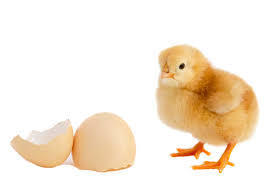
Ok, so which came first? The chicken or the egg, I mean paper or books? I think it is obvious that paper came first, but I guess that depends on what you call a book, doesn’t it? Writing came before paper or books, so if the definition of a book includes the cave painting that depicts a story, perhaps the book did come first. But that is neither here nor there in the quest for the answer to my question: Why is book art more recognized than hand papermaking?
Here are some of my ideas, and I hope that you will add yours in the comments below!
Are books more accessible than paper? I have tried many tactics when introducing myself to non-artists. It always takes a few sentences, and I don’t think that there is a distinguishable difference in reaction when I introduce myself as a book artist or a paper artist. However, I do think that people can more easily understand that you can make a book (haven’t we all made some sort of book in school) than the fact that you can make a sheet of paper (I never made a sheet of paper in school, although I do think it is more prevalent today).
Have you seen this papermaking video on Sesame Street?
Is paper too versatile? Paper can be a substrate, a sheet in and of itself, a sculpture, a pulp painting, a book, an installation, and more. Perhaps, since it can be presented in so many ways, it isn’t going to become famous in and of itself.
Is paper too commonplace? The digital age aside, we use and touch paper more than we do books (not to mention that most books are made of paper). And let’s face it, paper is cheap and disposable; a book holds more perceived value. Paper is everywhere, so it becomes invisible.
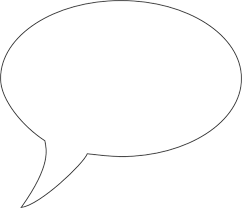
Is it the craft vs art thing? I’d love to see a thought bubble for the people I tell that I make art with paper. I mean, what are they really thinking? I’m guessing that they are reminded of the handful of shredded recycled paper they put into a blender and made into a crude sheet of paper in grammar school. That is recycling, and yes its super cool, but it takes a bit more than that to educate someone about paper as an art form.
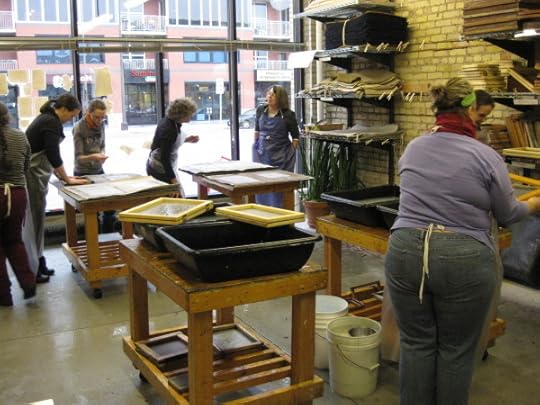
The paper studio at the Minnesota Center for Book Arts.
Is papermaking accessible? To make professional paper, you need specialized equipment. To a certain extent, this is true for book arts as well, but I think that the upfront papermaking costs are higher (a new Hollander beater, for example, runs $10,000). And in order to make paper, you need a suitable facility – one that can get wet. I often wonder what students of mine do after they leave me and the facility where I’m teaching. Many of them will will never make paper again.
I’ve spent my entire career trying to promote all levels of papermaking through my teaching, how-to books, exhibiting, placing my work in public spaces and public and private collections, and through social media, including this blog. I will continue to do this because I believe that paper is important in more ways than one!
And as you can see, I’m interested in the BIG (paper) PICTURE. I’ve just scratched the surface here. I’d love to hear your thoughts. Please leave a comment below!
April 18, 2015
The Sunday Paper #51
Work of the Week: I’ve been stitching a lot lately – embroidering words about motherhood onto a skirt which will be completed early next month – stay tuned! I love this poem by William Stafford, which talks about the threads that run through our lives. The Way It Is features a thread drawing that is trapped between sheets of handmade abaca paper. The poem is letterpress printed by Sandy Tilcock of lone goose press.
© 2009 Helen Hiebert, The Way It Is, edition of 50, abaca/hemp thread, 18″ x 12″, $175
This is a fascinating story about the Venerable Sukyong, a Korean Buddhist monk who is one of the few artisans who can make these traditional paper flowers (jihwa) from hanji, traditional Korean handmade paper. The tradition of making jihwa was on the verge of disappearing until Yeongsanjae, a Buddhist ritual, was included on the UNESCO’s Representative List of the Intangible Cultural Heritage of Humanity in 2009. This is a fascinating article, and those flowers – ooh la la!
I guess they weren’t making paper the day this video was made (I kept waiting to see footage) but Waste Warriors has been recycling waste and providing jobs for over twenty years in Upper Dharamshala, where the Tibetan government-in-exile is headquartered (and the place where the Dalai Lama resides). Papermakers, check out that rag cutter!
Check out this model for a paper bridge that will be built to span a mountain stream at the top of the Grisedale Valley, under the shadow of Helvellyn, from May 8-18. The artist is Steve Messam, and the piece is commissioned by Lakes Culture as part of its Lakes Ignite 2015 programme highlighting the region as a cultural destination (so go!). The paper is being specially formulated by Burneside papermaker James Cropper.
 This news is a bit old, and perhaps you’ve heard of the mystery book sculptor. I find this story fascinating – here’s an interview with the (anonymous) artist. I love this quote: “It’s no secret that I would like everyone to have access to books, art, artifacts and the buildings that house them. Not just those with the money for a ticket”.
This news is a bit old, and perhaps you’ve heard of the mystery book sculptor. I find this story fascinating – here’s an interview with the (anonymous) artist. I love this quote: “It’s no secret that I would like everyone to have access to books, art, artifacts and the buildings that house them. Not just those with the money for a ticket”.
This is really clever. Jillian Bruschera’s Mobile Paper Mill has a new component, The Papermaker’s Pack. Read about and see it here.
_______________________________________________________
About The Sunday Paper: The Sunday Paper is published by Helen Hiebert Studio. They keep saying that paper will become obsolete, yet artists, craftspeople, designers and creatives are keeping it alive and well. A healthy number of people are even making paper by hand (in some cultures they are still using age-old traditions). How cool is that? The Sunday PAPER is a resource for ideas and inspiration, all having to do with this amazing material. Each Sunday, I bring you stories and examples of people doing exciting, innovative, and beautiful things with paper, as well as links to interesting paperfacts I’ve unearthed from around the globe. I hope you’ll enjoy reading this paper, Papier, papel, хартия, Papir,紙, Papper, פּאַפּיר… and don’t hesitate to click on the link to leave your comments and suggestions!




